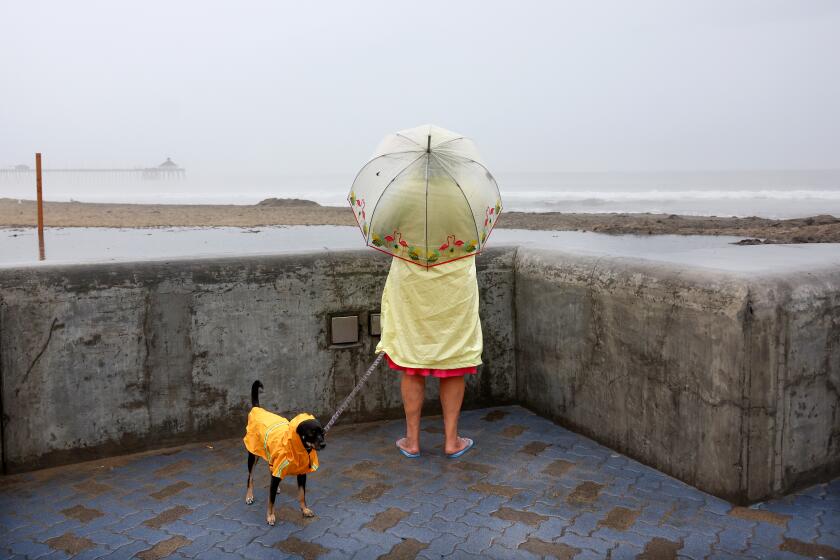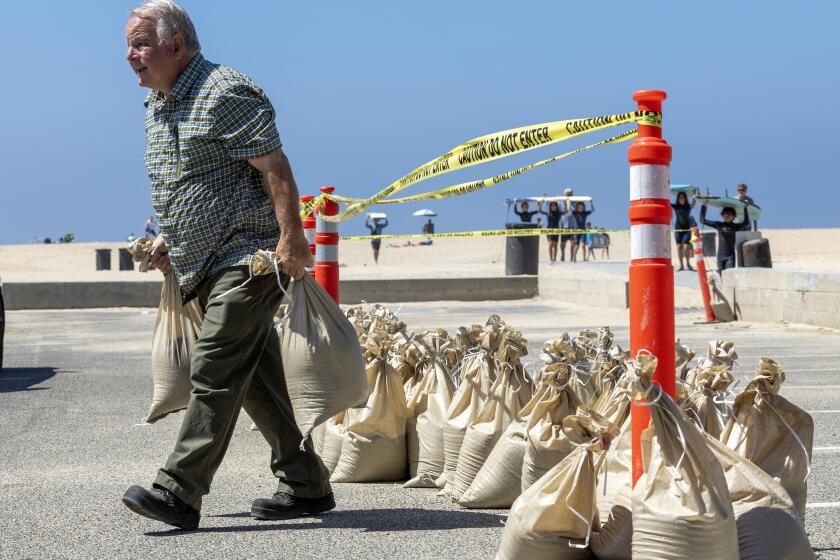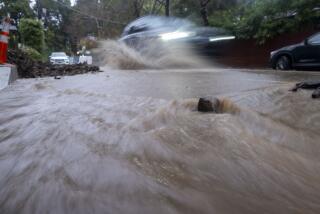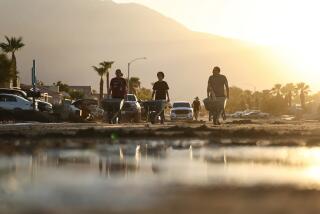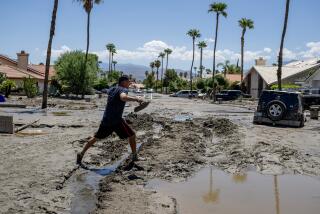‘Very, very dangerous’: Southern California frantically prepares as Hurricane Hilary barrels in
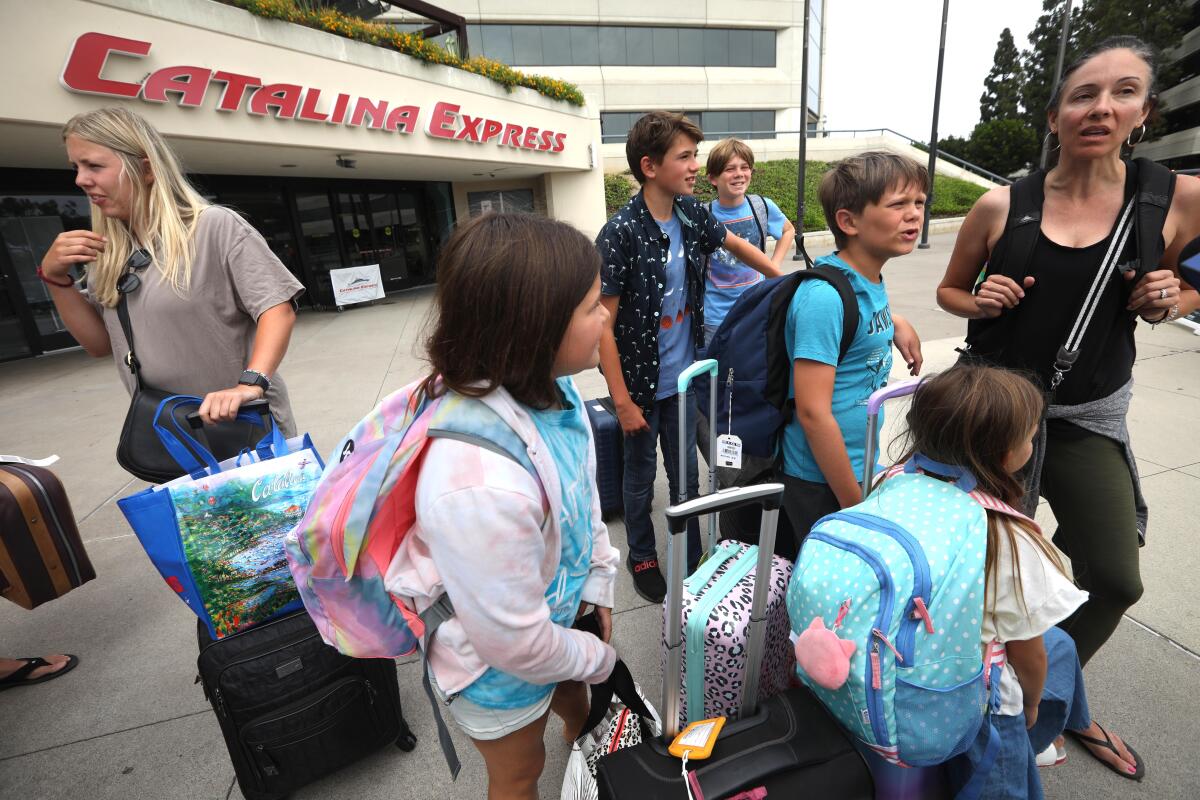
Hurricane Hilary continued its charge toward Southern California, bringing with it the potential for lashing wind and torrential rain and heightening fears over flooding, mudslides and extended power outages as residents scramble to prepare.
Meteorologists have warned that Hilary, which weakened to a Category 3 hurricane on Saturday and is expected to diminish further into a tropical storm before reaching Southern California, could cause “life-threatening” and “catastrophic” flooding. Mountain and desert areas are expected to be hardest hit.
On Saturday, people on Catalina Island were urged to evacuate ahead of Hilary’s arrival and travelers were advised to postpone trips to the popular destination. Several communities in San Bernardino County were also under evacuation warnings as rain began falling in the desert.
This could be “one of the most devastating storms that we’ve had in California in more than a decade,” Nancy Ward, director of the California Governor’s Office of Emergency Services, said during a press conference Saturday.
“Make no mistake, this is a very, very dangerous and significant storm,” she said. “Heavy rainfall and strong winds associated with this storm began today already and will be felt well beyond the center of the storm entering California.”
In advance of the storm, Gov. Gavin Newsom issued a state of emergency Saturday afternoon for much of Southern California to support Hilary response and recovery efforts.
Across Southern California, worried residents rushed to prepare for the first tropical storm to hit California since 1939. That storm dropped almost 8 inches of rain on Mt. Baldy in Los Angeles County and killed dozens.
Gray clouds loomed low over the San Jacinto Mountains on Saturday as dozens of Palm Springs residents swarmed a pit of sand at City Hall to fill bags to secure their houses from floodwater. People stood shoulder to shoulder — arms glistening with sweat from laboring amid the thick, hot air.
The city has handed out more than 22,000 sandbags since Friday morning and 20,000 more were on track to arrive Saturday afternoon.
“Since yesterday about 8 a.m., the crowds have been just like this all day. Nonstop,” said Daniel Martinez, the acting deputy director for the Department of Maintenance and Facilities. “As soon as it gets here, you’ll see the sand disappear.”
In a neighborhood near downtown Palm Springs, 55-year-old Anna Caterinicchia rushed to lug bags of sand out of her car, while a contractor drove an electric wet saw into her cement driveway. She hired him to build a “quick and dirty” drain in front of her garage — 1 foot deep — to save her house from potential flooding.
“This isn’t normal for us and everybody is panicked,” she said.
Caterinicchia, a Chicago native who moved to Palm Springs two years ago in search of sunshine and a daily swim, said her California dream might end with this storm.
“I’m going back home,” she said. “I’d rather shovel snow.”
An unprecedented tropical storm warning is in effect from the California-Mexico border to Point Mugu and for Catalina Island.
The National Weather Service has issued a tropical storm warning for much of Southern California — from Point Mugu to the U.S.-Mexico border — warning of strong winds, heavy rain, possible flooding and dangerous beach conditions.
Los Angeles, Orange and San Diego counties could see up to 3 inches of rain between Sunday and Monday. While that’s far more moisture than is typical for August, the mountains and deserts are expected to see the most moisture, with up to 12 inches of rainfall possible in some areas, according to the National Weather Service.
“The system has gained some speed, and it’s going to be moving through a little bit on the quicker side. By the time we get to Monday afternoon or so we’re expecting most of the precipitation to have moved out of the area aside from a few lingering showers,” said Ariel Cohen, the meteorologist in charge at the National Weather Service in Oxnard.
This could cut down on rainfall totals in some areas, Cohen said, “but there’s so much moisture pushing into the area that we’re still looking at the potential for flooding.”
Forecasters expect sustained winds whipping through the area at 35 to 45 mph. The highest gusts — up to 50 or 60 mph — are expected in the mountains and deserts.
Residents rushed to stock up on household essentials like water and batteries, leaving grocery aisles bare. At the 99 Cents Only Stores on Sunset Boulevard in Silver Lake, gallons of bottled water, battery-powered tea lights and pillar candles were selling fast.
Daniel Flores, 54, of Echo Park, went in looking for nylon rope to secure a tarpaulin across the top of his Oldsmobile Cutlass, which he parks outside. The sedan has a broken window, which he’d decided to wait to fix because the summer is usually so dry.
“Who expects a hurricane in L.A.?” Flores said.
Hurricane Hilary is a reminder to sign up for services that alert you when storms, extreme heat, earthquakes, tsunamis or fires threaten or hit an area.
On Catalina Island, some residents and tourists were rushing to leave on boats Saturday afternoon ahead of Hilary’s arrival. Officials have said there could be prolonged utility outages on the island, home to about 4,000 year-round residents, and boat service to and from the island is not likely to resume before Tuesday.
The Catalina Flyer ferry service, which runs between Avalon and Newport Beach, was near capacity for its final two runs back to the mainland on Saturday.
Gina McMullen, 47, of Oceanside had traveled to Catalina on Thursday for a weekend away, but the family decided to cut their trip a day short when they got an alert about evacuations.
The mood on the island amid the packing up was calm. No one was outwardly panicking, McMullen said.
“I just hope the storm doesn’t cause as much damage as people think — you just heard about all the wildfires on Maui, and now to think about another little island getting some destruction, it just makes me really sad,” McMullen said. “I’m hoping everyone is being cautious, and it’s going to turn out better than we thought.”
In Los Angeles, officials overseeing the county’s seven jails are trying to anticipate what Hilary’s impacts might be on the county lockups.
Though the jails have dealt with leaks and drips in the past, Assistant Sheriff Sergio Aloma said they don’t have a history of major storm-related flooding and there were no plans to cancel regularly scheduled weekend visitation. Jail staff are preparing to open a temporary Custody Emergency Operations Center on Sunday morning and move to 12-hour shifts to increase staffing levels during the storm.
Still, some families and advocates for inmates were concerned. People in jails and prisons are particularly vulnerable to the effects of extreme weather, including storms, wildfires and scorching heat — all threats that prisoners have little ability to avoid inside locked cells.
“I’m in a constant state of worry,” said Darrell Munn, whose son has been in Twin Towers for six years. “The jails are old and dilapidated.”
Tropical Storm Hilary threatens heavy rains, flash flooding, high winds and intense surf across Southern California this weekend. Here’s what to expect.
Around 12:45 p.m. Saturday, the San Bernardino County fire station in Twentynine Palms ran out of sandbags for the second time in as many days. The station gave out about 2,500 bags Friday and 3,000 Saturday, a firefighter said as he taped a sign to the door informing residents that they had no more.
Rebecca Rasmusson and Martin Reem, both Marines, loaded up on water and groceries, including food that can be grilled if the power goes out. They checked their stash of flashlights and put gas in the car. But they had been arguing about whether they needed sandbags.
“I figured we might as well put in the work now so we’re not sorry later,” Rasmusson said in the fire station parking lot as she scooped sand into a bag. “We’re preparing for the worst.”
Rasmusson is from Oklahoma, the so-called buckle of the tornado belt, and Reem is from Minnesota, where snowstorms are common.
“Now we get the trifecta with this hurricane,” Rasmusson said.
Mark Powell, a 50-year resident of San Bernardino County, said he’s not too concerned about himself, as his home is near a ridge. But he’s worried about people in low-lying areas, he said, citing the potentially historic strength of the storm.
“I’ve seen some pretty bad ones, but if it hits like they’re forecasting, this would be the big one,” he said.
Times staff writers Connor Sheets, Keri Blakinger, Jaclyn Cosgrove, Ruben Vives and Rong-Gong Lin contributed to this report.
More to Read
Sign up for Essential California
The most important California stories and recommendations in your inbox every morning.
You may occasionally receive promotional content from the Los Angeles Times.
